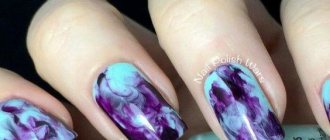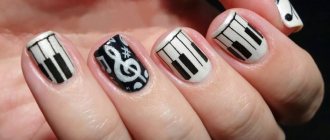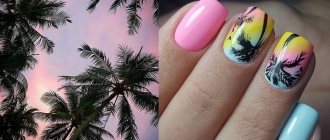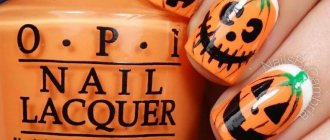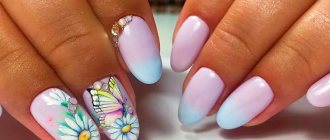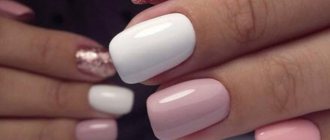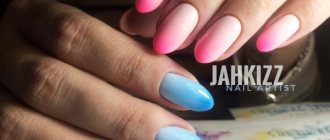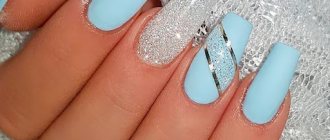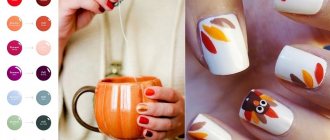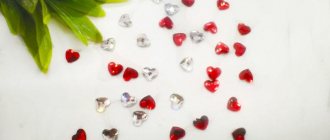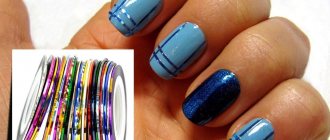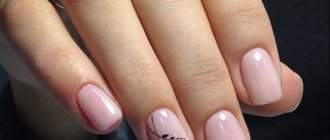What textures are there and how to create them
Textures are an imitation of stones, sea, sky and any other, even fictitious patterns. Creating a design is much easier than it might seem - practically no drawing skills are needed, and the list of necessary materials is available to every master.
There are at least two options on how you can create a beautiful textured manicure:
- Immediately on the nail;
- On a palette with subsequent transfer.
Directly on the nail plate
To create a picture you will need 2-3 gel polishes of different shades and a thin brush.
- Place gel polish on the prepared background, which will be the main one in the texture. This can be done with chaotic strokes or according to some thoughtful scheme;
- Using a thin brush, pick up the second color and apply short, thin strokes over the wet gel polish. They will mix and flow in random order, creating unusual mixtures of colors;
- Add another color if necessary or use the same gel polish to make a few more lines;
- Dry the gel polish and apply top coat.
There is a similar option, but with painting not on wet gel polish, but on dry one:
- Apply the main texture color and dry;
- Remove the sticky layer and use a thin brush to make short, thin strokes with the second color;
- Wipe the brush with degreaser and blend the resulting strokes in different directions;
- Dry the design and cover with top coat.
The second option is to create a design on a palette
- Place a drop of gel polish on the palette in the main color of the future design;
- Add a second gel polish to the center of the drop, and then, if necessary, a third or glitter;
- Using the sharp end of an orange stick, lightly mix the gel polishes directly on the palette to form smooth mixtures. Do not overdo it - the colors should not mix, forming a mess - the goal is only to provoke the formation of intertwined colors;
- Carefully pick up the resulting texture color with a gradient brush and transfer it to the nail;
- Dry and cover with top coat.
You can create textures on the entire nail or part of it, cover it with a matte or glossy top, and complement it with designs - foil, sparkles, rhinestones.
Style combinations of textures
A style combination of textures is a combination characteristic of a particular style. Where, sometimes, the logic of contrasts collapses. After all, it was not interior styles that dictated what to combine with what. And the combinations created the concept of style. The reasons were also different, from the availability of materials to historical events related to the time of formation of the style:
The styles of the mid-20th century, sometimes rebellious, created many combinations that were considered incompatible - industrial, loft.
Modern Scandinavian style - the usual Scandinavian snow-whiteness in combination with wood was diluted with bright details: plant, floral, geometric prints and deep dark color.
Base your ideas on combinations on basic elements that you already have, or those that you really want to use. Surely there will be a connection with the era or style.
Sharp contrasts in the combination of textures
An example of a sharp contrast in textures was the art studio “Factory” by Andy Warhol. Where the entire interior of the room was painted silver.
A striking contrast is the combination of familiar shapes with an unusual texture:
When combining textures, you need to take into account the relationship of textures with color, texture, and shapes. Every texture has color and texture to which shape can be added. When combining, it is necessary to take into account all relationships.
About how to combine shapes - in the next blog article, from the series: about combinations in the interior.
The new article describes a combination of shapes, lines, and patterns in interior design.
Subscribe to notifications of new publications by email or on social networks:
| Add to our groups on social networks: |
For long nails
Imitating sea waves in blue or light blue is the most common idea. It is equally good for both long and short nails. The best background is a milky base or nude. In this case, the bright pattern stands out favorably.
But there are also unexpected solutions - blue waves on a blue background. To create such a design, you can paint directly onto the wet blue base, rather than creating additional layers, as we described at the beginning of the article.
Purple or pink-purple designs are often found. These patterns resemble the color of amethyst.
If you want a more calm design with a textured pattern, then use basic colors for drawing - brown, black, gray, white and a calm background.
Since textures are a general term for different colors, don't limit yourself to rocks or the sea. A beautiful manicure using this technique can be created in different colors, even those not related to natural resources.
Original design, similar to a flame or a volcano. Quite a bold decision, but very fascinating.
Fashionable manicure with lots of glitter. It will look stylish on a square - as in the photo, as well as on an almond or oval. But on short plates it is better not to do such a design - the design “eats up” space.
A combination of two textures of different colors - blue and red. Since the design is made on a calm light background, the bright design is not perceived as too pretentious, which makes it universal - for relaxation, for a wedding, and for the office.
For short nails
On short nails, it is recommended to avoid completely covering the plates with a textured pattern so that it does not “eat up” the length. However, there is no need to completely abandon this design - accents on several nails or partial coverage of all nails look great.
The shape can be any - square, oval, almond. The colors are mostly light, even in the pattern itself.
Don’t forget about the gradient - it can be stretched not only within one nail, but throughout the entire hand.
Stylish manicure for short nails in the shape of a square and with a delicate pink-beige imitation of quartz.
A combination of two fashionable techniques - textured patterns and speckles. Specks can be created with a tousled brush, which is barely touched and dipped in black gel polish.
Another delicate manicure, complemented by inscriptions.
Shades of purple often find their place on short nails. On a milk base or white gel polish, this design looks especially original.
A very original manicure – a combination of red and purple. You can add glitter or foil to this decor.
Again tenderness and an excellent combination of two designs - gradient and textures. The pattern is drawn on a wet background.
Design with imitation stone - jade or rose quartz. A great alternative to a nude manicure, but with the same calmness and versatility.
Don't forget about turquoise and emerald shades. They have been popular for several years, and when combined with black “veins” they give a chic turquoise effect.
For a calm design, use appropriate colors - basic black and white, gray and brown. Gray manicure, by the way, is now at the peak of popularity, as it is the color of the year.
An original manicure reminiscent of something cosmic. This option is good for both long and short nails.
Despite the recommendation to use light shades on short nails, some nail artists successfully create manicures with textures made of darker, brighter colors. With the right combination, even on short nail plates, such a design looks light and floating.
And finally, the use of pink. This design is not found often, but that doesn’t make it look any less original.
Ways to combine textures
Natural combinations
There is no more natural combination of materials than nature. Nature provides strong emotional contrasts. With the difference that matter is combined in nature, and they become materials after human processing. Natural materials are divided into natural: wood, stone - and recycled. But, here we need to clarify something...
Natural materials include those processed materials that are obtained either from a slight change in the original material or materials obtained from natural materials historically available to humans - without modern high-tech processing.
Natural natural and recycled materials:
Tree -
naturally transfers to wood as a material.
Stone -
It can be natural and processed from natural, natural and artificial, as well as a material similar in properties to stone: concrete, clay, gypsum.
Clay
— and its derivatives: ceramics, brick.
Gypsum
- a close relative of stone, can act as an independent material.
Metal
- important - primary and rough processing, as a material close to nature. Stone and metal as textures are perceived closely: heavy, cold.
Plants
may be presented as plant material, similar processed products, live or artificial plants.
Glass
- also a material close to natural.
Textile
- important - natural fabrics of primary processing: linen, ramie, cotton, silk.
Water
— can be either natural or something similar to it, such as glass or light fabric.
There are many interior styles in which natural combinations dominate: country, Scandinavian, tropical styles. For ethnic styles, this is a combination of materials natural to the region:
Scandinavian style is the art of combining wood, stone, and textiles.
The chalet style is the kingdom of stone and wood, as an attribute of the homeland - Switzerland.
A strong visual property of natural materials: they convey an emotion of calm, and the closer the material is to naturalness, the stronger it is.
Natural materials in the interior are like butter in porridge - you can’t spoil them with them. But you can overdo it. The main enemies of natural materials are artificial, synthetic and high-tech. This must be taken into account when combining.
Advanced materials: a combination of synthetic, recycled and man-made materials
What's happened.
The combination of modern materials creates emotional contrasts. They are built on the sensory perception of materials. The strongest emotion of synthetic, high-tech recycled and man-made materials is modern materials - a product of the 20th and 21st centuries.
If roughly processed metal is classified as natural, then modern metals with their high-tech processing are already classified as artificial. For example, cast iron is close to natural, chrome is modern, high-tech. Chrome surfaces in natural or country interiors will look like sneakers with a tuxedo. In modern interiors - as an attribute emphasizing modernity.
About the textures of modern materials. The primary purpose of modern materials is to replace and complement natural ones. Therefore, they do not actively form new textures, but are more often imitations. But, something fresh from the textures stands out:
In metals - textures of new types of metals, and metal processing.
Decorative finishing includes plaster textures.
Plastic, rubber - as an attribute of modern interiors can act as a texture.
Seventies style shine
Examples:
Interiors of the mid-20th century became an era of brilliance and gloss, with the corresponding emotional message of Shine.
Touch coatings have become an attribute of restrained emotions in modern interiors. Touch coatings that resemble rubber in appearance are a mixture of pleasant tactile and visual sensations, often used in automotive finishing and technology. The coatings also moved into interiors with appliances, finishing materials and decor.
When combining modern and natural natural materials, you need to think about the idea of relationship. For example, this floor lamp made of glass, imitating a raincoat mushroom - a modern material combined with natural ones:
Floor lamp
Matte
A manicure with a “texture” design under a matte top is a separate form of art. The top evens out bright blue or emerald colors and makes the design weightless.
A very original nail design combining Ruffian and textures.
Here's a great example of how to make accents - just 1 nail with a pattern reminiscent of a splash of a wave, and a simple matte nude turns into a unique fashionable decor.
And again blue-blue, but no longer a sea, but a heavenly texture.
Two options in brown shades. Looks great on long nails.
A floating texture, the manicure with which resembles either colored smoke or stone.
What is material and texture in interior design
Material is what an object is made of. Materials are divided into three main groups: natural, recycled and synthetic.
Texture is the surface of an object that shows the material from which the object is made. Texture is also conveyed by a pattern on the surface of an object, indicating the material from which the object is made.
The concepts of texture are often confused or mixed with texture; you will read about the difference between terms in our article: how texture differs from texture.
The material and texture may not match, and then the item is called an imitation.
For the purposes of interior design and decoration, texture is primarily of interest .
With design
Texture patterns look great on their own, but you can still complement the manicure - the main thing is not to overdo it.
A common option is a combination of textures with gold leaf or foil. They place accents or delineate the boundary between texture and background.
You can use sliders as a background, in this case with an inscription.
Or add popular adhesive-based tapes.
Do you like manicures with textures?
Share in the comments which way you achieve a fashionable effect? Comment
